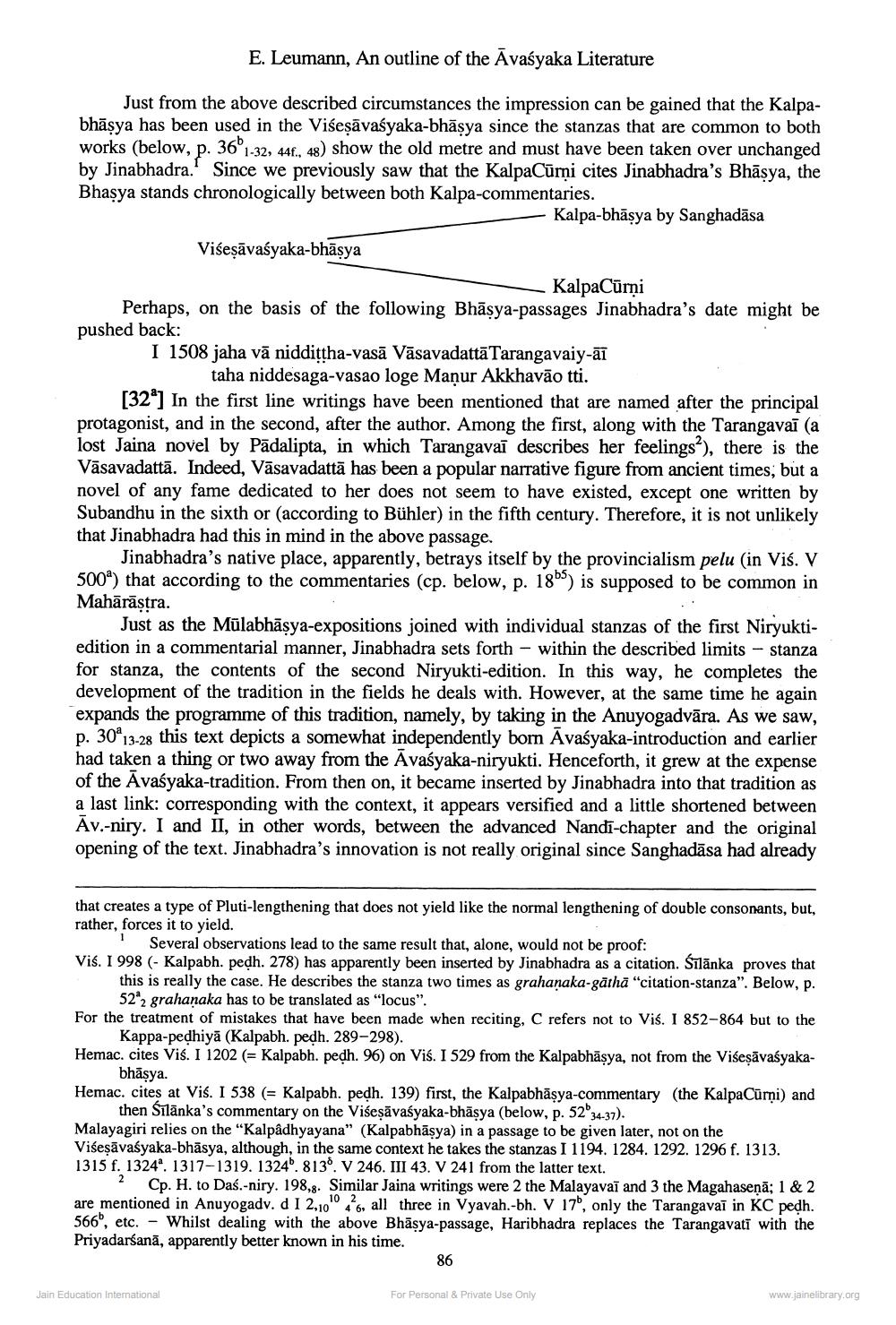________________
E. Leumann, An outline of the Avaśyaka Literature
Just from the above described circumstances the impression can be gained that the Kalpabhāṣya has been used in the Viseṣāvaśyaka-bhāṣya since the stanzas that are common to both works (below, p. 36b 1-32, 44f., 48) show the old metre and must have been taken over unchanged by Jinabhadra. Since we previously saw that the KalpaCumi cites Jinabhadra's Bhāṣya, the Bhasya stands chronologically between both Kalpa-commentaries.
Kalpa-bhāṣya by Sanghadāsa
Viseṣāvaśyaka-bhāṣya
KalpaCūrni
Perhaps, on the basis of the following Bhāṣya-passages Jinabhadra's date might be pushed back:
I 1508 jaha vā niddiṭṭha-vasā Vasavadatta Tarangavaiy-ãî taha niddesaga-vasao loge Maṇur Akkhavão tti.
[32] In the first line writings have been mentioned that are named after the principal protagonist, and in the second, after the author. Among the first, along with the Tarangavai (a lost Jaina novel by Padalipta, in which Tarangavai describes her feelings2), there is the Vasavadattā. Indeed, Vasavadatta has been a popular narrative figure from ancient times, but a novel of any fame dedicated to her does not seem to have existed, except one written by Subandhu in the sixth or (according to Bühler) in the fifth century. Therefore, it is not unlikely that Jinabhadra had this in mind in the above passage.
Jinabhadra's native place, apparently, betrays itself by the provincialism pelu (in Viś. V 500) that according to the commentaries (cp. below, p. 1865) is supposed to be common in Mahārāṣtra.
Just as the Mulabhāṣya-expositions joined with individual stanzas of the first Niryuktiedition in a commentarial manner, Jinabhadra sets forth - within the described limits - stanza for stanza, the contents of the second Niryukti-edition. In this way, he completes the development of the tradition in the fields he deals with. However, at the same time he again expands the programme of this tradition, namely, by taking in the Anuyogadvāra. As we saw, p. 30° 13-28 this text depicts a somewhat independently born Avaśyaka-introduction and earlier had taken a thing or two away from the Avaśyaka-niryukti. Henceforth, it grew at the expense of the Avaśyaka-tradition. From then on, it became inserted by Jinabhadra into that tradition as a last link: corresponding with the context, it appears versified and a little shortened between Av.-niry. I and II, in other words, between the advanced Nandi-chapter and the original opening of the text. Jinabhadra's innovation is not really original since Sanghadāsa had already
that creates a type of Pluti-lengthening that does not yield like the normal lengthening of double consonants, but, rather, forces it to yield.
1
Several observations lead to the same result that, alone, would not be proof:
Viś. I 998 (- Kalpabh. pedh. 278) has apparently been inserted by Jinabhadra as a citation. Šīlānka proves that this is really the case. He describes the stanza two times as grahaṇaka-gāthā “citation-stanza". Below, p. 522 grahanaka has to be translated as "locus".
For the treatment of mistakes that have been made when reciting, C refers not to Vis. I 852-864 but to the Kappa-peḍhiya (Kalpabh. peḍh. 289-298).
Hemac. cites Vis. I 1202 (= Kalpabh. pedh. 96) on Viś. I 529 from the Kalpabhäṣya, not from the Viseṣāvasyaka
bhāṣya.
Hemac. cites at Vis. I 538 (= Kalpabh. peḍh. 139) first, the Kalpabhāṣya-commentary (the KalpaCūrṇi) and then Silanka's commentary on the Viseṣavasyaka-bhāṣya (below, p. 52° 34-37). Malayagiri relies on the "Kalpâdhyayana" (Kalpabhāṣya) in a passage to be given later, not on the Viseṣāvaśyaka-bhasya, although, in the same context he takes the stanzas I 1194. 1284. 1292. 1296 f. 1313. 1315 f. 1324. 1317-1319. 1324b. 813°. V 246. III 43. V 241 from the latter text.
2 Cp. H. to Daś.-niry. 198,8. Similar Jaina writings were 2 the Malayavai and 3 the Magahaseṇā; 1 & 2 are mentioned in Anuyogadv. d I 2,100 46, all three in Vyavah.-bh. V 17b, only the Tarangavai in KC pedh. 566, etc. Whilst dealing with the above Bhāṣya-passage, Haribhadra replaces the Tarangavati with the Priyadarśanā, apparently better known in his time.
86
Jain Education International
For Personal & Private Use Only
www.jainelibrary.org




